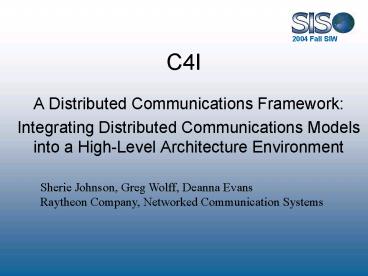C4I - PowerPoint PPT Presentation
1 / 16
Title:
C4I
Description:
Integrating Distributed Communications Models into a High-Level ... Birds-Eye-View. RTI. Federate. Simulation. Object. Simulation. Object. Simulation. Object ... – PowerPoint PPT presentation
Number of Views:782
Avg rating:3.0/5.0
Title: C4I
1
C4I
- A Distributed Communications Framework
- Integrating Distributed Communications Models
into a High-Level Architecture Environment
Sherie Johnson, Greg Wolff, Deanna Evans Raytheon
Company, Networked Communication Systems
2
Agenda
- Overview of Communications in Distributed
Simulations - Distributed Approach Framework
- Architecture
- Example Scenario
- Communications Message Support
- GeoEnvironmental Support
- Interfaces
- Conclusion
3
Overview of Communications in Distributed
Simulations
- Distributed Simulations used for Operational
Scenario Assessment and Engineering Assessment - Traditionally, Communications modeled as a
standalone-separate federate. - Bottleneck
- Reduced likely-hood
- of real-time of faster
- simulations.
- Need for distributed,
- efficient, and effective
- communications effects
- models.
4
Distributed Approach Framework
- Distributed Communications Effects Module (DCEM)
- Flexible Design allows
- Low (stochastic) to
- high fidelity (discrete)
- models
- Real-time or faster
- HLA compliance
- Intra and Inter-federate
- comm. support
- Network-Centric
- architecture capable
DCEM
SIM X
SIM Y
DCEM
DCEM
DCEM
SIM Z
SIM W
5
DCEM Architecture
A single of Communications Effects Server (CES)
provides global or system-wide information
A collection of Communications Effects Protocols
(CEPs) provide communications support to one or
more simulation objects
Birds-Eye-View
DCEM
DCEM
CEP
CES
CEP
CES
Federate
Federate
Simulation Object
Simulation Object
Simulation Object
RTI
Simulation Object
Simulation Object
Simulation Object
Simulation Object
Simulation Object
6
DCEM - Precision Engagement Example
Command/Control
System Simulation
Sensors
Link16
Link16
Link16
DCEM
Satcom
WDL
WDL
RTI
Satcom
WDL
WDL
WDL
Weapons
Ground Stations
7
Command/Control
System Simulation
Sensors
Link16
Link16
Link16
DCEM
Satcom
WDL
WDL
RTI
Satcom
WDL
WDL
WDL
Weapons
Ground Stations
8
Command/Control
System Simulation
Sensors
Link16
Link16
Link16
DCEM
Satcom
WDL
WDL
RTI
Satcom
WDL
WDL
WDL
Weapons
Ground Stations
9
Command/Control
System Simulation
Sensors
Link16
MPCDL
Link16
Link16
DCEM
Satcom
WDL
WDL
RTI
Satcom
WDL
WDL
WDL
Weapons
Ground Stations
10
Command/Control
System Simulation
Sensors
Link16
Link16
Link16
DCEM
WDL
WDL
Satcom
RTI
Satcom
WDL
WDL
WDL
Weapons
Ground Stations
11
Command/Control
System Simulation
Sensors
Link16
Link16
Link16
DCEM
Satcom
WDL
WDL
RTI
Satcom
WDL
WDL
WDL
Weapons
Ground Stations
12
Communications MessageSupport
- For High-Level Architecture (HLA) 1
environments - Propose a Communications Effects Base Object
Model (BOM) - Communications Interaction (Base Class)
- Used by all entities within a federate that wish
to have communications effects applied to
messaging - Base class carries protocol independent
information - Subclasses of Communications Interaction would
carry protocol specific info - Non HLA environments
- Communications Class/Structure
Interaction1
Interaction2
Interaction3
JTIDSComm
Communications
Link16Comm
MPCDLComm
Datalink/Protocol specific parameters
Datalink/Protocol independent parameters
GenericComm
13
Communications MessageSupport (cont)
- Parameters of Base Class
- OriginatingEntity unique identifier of the
sending entity - ReceivingEntity - unique identifier of the
intended recipient entity - Tactical Data Length Type the type of subclass
encapsulated - Effect used for receive-end processing,
contains the effect to be applied. - Example Parameters of SubClasses
- Payload
- Protocol Specific Info (i.e., NPG for Link16)
- Link16RadioSignal Interaction
- Draft Link 16 Simulation Standard
SISO-STD-002-V2.8 DRAFT- 19 April 20042 could
be implemented within this framework
14
DCEM GeoEnvironmental Support
- DTED 0 and DTED 1 Support
- The following methods available to all
Datalink/Protocol Models - SimpleLOS Spherical Earth Model
- TerrainLOS DTED based
- CalcDistance Determines linear distance between
two entities. - Assumptions
- Entity Updates (position information) for all
entities requiring communications support must be
available - Either via the distributed backbone or other
mechanisms. - Entity updates must be able to be correlated with
Originating Entity/Receiving Entity from
Communications Interaction
15
DCEM Interfaces
- DCEM supports a well-defined API for providing
communications effects in a distributed
simulation environment. - Flexible design allows the internal jewels of
the framework to not be dependent on the
underlying distributed simulation environment. - Many distributed environments
- supported
- HLA directly
- UDP Sockets
- Middle-ware
- The DCEM is accessible
- directly via the API, or
- via supplied DCEM wrappers which implement the
underlying distributed simulation environment
specifics.
16
Conclusion and References
- DCEM is a next generation framework for providing
communications effects in a distributed
simulation environment - The DCEM provides new capabilities that to-date
have not been provided through Traditional
approaches. - The DCEM framework has successfully been
demonstrated in two different simulator
configurations. - References
- 1 High-Level Architecture (HLA) Run-Time
Infrastructure (RTI) 1.3 Next Generation (NG)
Programmers Guide Version 3, April 2000. - 2 Draft Link 16 Simulation Standard
SISO-STD-002-V2.8 DRAFT- 19 April 2004.































